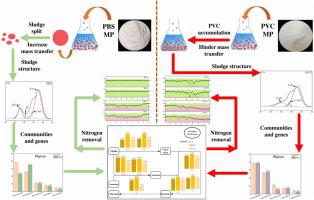Journal of Hazardous Materials ( IF 13.6 ) Pub Date : 2020-06-30 , DOI: 10.1016/j.jhazmat.2020.123337 Linqin Tang 1 , Chengyuan Su 1 , Yu Chen 2 , Yunchuan Xian 2 , Xinyue Hui 2 , Ziyu Ye 2 , Menglin Chen 2 , Fenghua Zhu 2 , He Zhong 2

|
Microplastics (MPs) has been widely detected in wastewater treatment plants. However, there is a lack of research on its influence on anaerobic ammonia oxidation (anammox) process. Therefore, the effects of polybutylene succinate (PBS) and polyvinyl chloride (PVC) MPs on the nitrogen removal performance, microbial community and metabolites of anammox sludge were investigated. Results showed that PBS and PVC MPs reduced the nitrite removal efficiency of the anammox sludge, and PVC1 (0.1 g/L PVC) group was the most significant at 19.2 %. Fourier transform infrared (FTIR) and X-ray photoelectron spectroscopy (XPS) spectra showed that PBS2 (0.5 g/L PBS) group increased the polysaccharide content in the anammox sludge. This may be because of the byproduct, which was produce during the biodegradation of PBS MPs, and decrease the agglomeration capacity of sludge, so as to increase the mass transfer. PBS2 group reduced the relative abundance of Methanosaeta (10.18 %) and the methane modules, and stimulated the anammox bacteria Ca. Brocadia (1.17 %) and the relative nitrogen metabolism modules. PVC2 group reduced the relative abundance of Ca. Brocadia (3.02 %), while was enriched Methanosaeta (2.1 %). Non-biodegradable PVC MPs was more harmful to anammox sludge, which would draw attention to the entry of PVC MPs into the anammox system.
中文翻译:

可生物降解的聚丁二酸丁二酯和不可生物降解的聚氯乙烯微塑料对厌氧污泥的影响:性能评估,抑制效果和宏基因组分析。
在废水处理厂中已广泛检测到微塑料(MPs)。然而,关于其对厌氧氨氧化(anammox)过程的影响,尚缺乏研究。因此,研究了聚丁二酸丁二酯(PBS)和聚氯乙烯(PVC)MP对厌氧污泥脱氮性能,微生物群落和代谢产物的影响。结果表明,PBS和PVC MPs降低了厌氧氨氧化污泥的亚硝酸盐去除效率,PVC1(0.1 g / L PVC)组最显着,为19.2%。傅里叶变换红外光谱(FTIR)和X射线光电子能谱(XPS)光谱表明,PBS2(0.5 g / L PBS)组增加了厌氧菌污泥中多糖的含量。这可能是由于副产物在PBS MP的生物降解过程中产生的,降低污泥的团聚能力,增加传质。PBS2组降低了相对丰度甲烷菌(10.18%)和甲烷模块,并刺激了厌氧细菌Ca。Brocadia(1.17%)和相关的氮代谢模块。PVC2组降低了Ca的相对丰度。Brocadia(3.02%),而富含Methanosaeta(2.1%)。不可生物降解的PVC MPs对厌氧菌污泥的危害更大,这将引起人们对PVC MPs进入厌氧菌系统的关注。


























 京公网安备 11010802027423号
京公网安备 11010802027423号